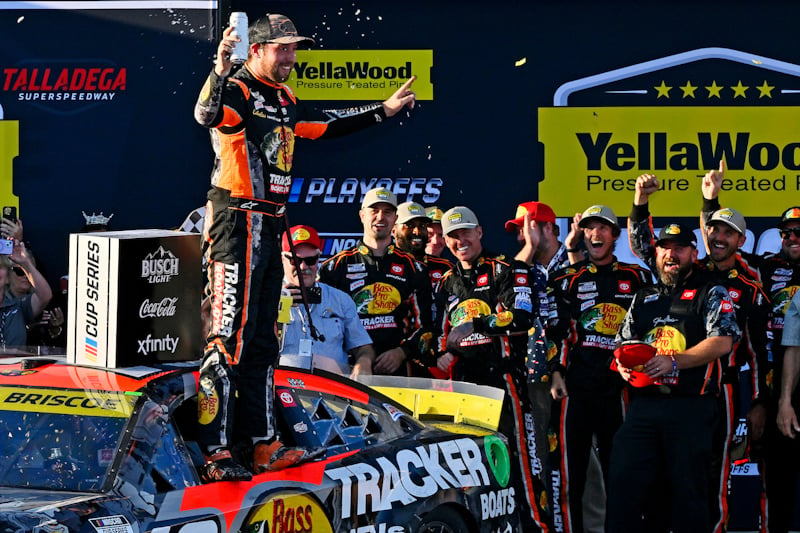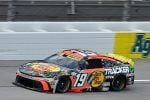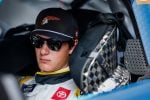Who… should you be talking about after the race?
Entering the day with a solid-but-not-insurmountable 15-point gap over the playoff cut, Chase Briscoe kicked off the weekend by qualifying on the front row at Talladega Superspeedway on Sunday (Oct. 19) alongside polesitter Michael McDowell.
In a race that featured 77 lead changes among 27 drivers, Briscoe didn’t lead a lap in the first stage. He won the second stage and the points that came with it but didn’t make a lot of noise.
What Briscoe did make was an opportunity. When Kyle Larson ran out of fuel in front of fuel in overtime, Briscoe took advantage of the last-lap chaos to battle Todd Gilliland and Bubba Wallace for the win. Briscoe got an advantage in the trioval coming to the checkered flag and held off Gilliland to win the YellaWood 500 by .145 seconds.
Ty Gibbs finished third and Wallace fourth. Cole Custer rounded out the top five with his best finish since finishing fourth at Daytona International Speedway in August.
The win is Briscoe’s fifth overall in the NASCAR Cup Series, third in 2025 and his first on a superspeedway. He joins teammate Denny Hamlin as two of the four drivers in this year’s championship race in two weeks at Phoenix Raceway. It will be Briscoe’s first Championship 4 appearance.
On the other hand…
The playoffs always highlight a bad weekend, but for Hendrick Motorsports, it was a struggle from the first stage, when Chase Elliott got the brunt of a lap 52 pileup that left the driver of the No. 9, who had entered the weekend 25 points below the championship cut line, in 40th place and an even deeper playoff hole.
Alex Bowman finished six laps down in 29th with mechanical issues.
The organization still had high hopes for a win, with William Byron and Kyle Larson racing for the win and lined up at the front on the final restart. Larson, in his milestone 400th Cup start, ran out of fuel during the two-lap overtime duel. Byron lost momentum avoiding Larson and fell back into the pack, where he spun on the final lap and fell to 25th in the final running order.
Larson is still solidly ahead of the cut line, but barring a win from Byron or Elliott next week, he’ll likely be the only Hendrick entry in the title race in two weeks.
What… does this mean for the points standings?
While superspeedway racing is a specific skill and one that should test the payoff drivers, maybe having the race this late in the postseason should be reconsidered.
Heading into the final cut at Martinsville Speedway next week, the cut line is clearly defined … so much so that the only likely hope for a shakeup is one of the four drivers below the line winning the race.
Briscoe and Hamlin already punched their tickets to the title race with wins. Christopher Bell is currently third, 37 points to the good, with Larson just one behind him.
Byron is the first driver on the wrong side of the points, 36 behind Larson, while Joey Logano is 38 behind. While Byron could theoretically oust Larson, he’d have to have a virtually perfect race while Larson falls out first with no stage points. Weirder things have happened, but it’s highly unlikely. It’s even more so for Logano, who would not only have to have a perfect race and a disaster for Larson but would also have to get past Byron. Either of them getting in on points is a stretch.
Ryan Blaney and Chase Elliott are seventh and eighth, respectively. They’d need a win to advance.
This means that only one position might realistically change hands, and while it will produce some excitement if one of the four underdogs is in position to win, if they are not and if Larson and Bell run even a mediocre race, the drama that NASCAR defines the playoffs with will be nonexistent.
Where… did he come from?
The race featured a few finishers who passed a lot of cars to get there. Three of the top 10 finishers started outside of the top 20. The biggest gains of the day came from Carson Hocevar, who gained 26 spots to finish sixth and Gilliland, who finished second after starting 27th for a net gain of 25.
Shane van Gisbergen had a net gain of 20 after starting 31st and finishing 11th, despite a pit road spin that left him stuck in the trioval grass and cost him a lap. It’s van Gisbergen’s second-best oval finish.
The fourth driver to gain 20 or more spots start to finish was part-timer Casey Mears, who has run a handful of races for MBM Motorsports. Mears started 40th and worked his way up to 18th, coming from a lap down to post MBM’s best finish in five years.
When… was the moment of truth?
While the race was relatively tame by superspeedway standards, there was still plenty of talk devoted to the “Big One.”
At one point late in the race, play-by-play broadcaster Leigh Diffey noted that the stage one crash that involved nine cars was “not that big of a big one.” (It still took seven cars out of the race.)
Races are better off without the huge pileups, but both the TV networks and NASCAR still push them as the real drama.
Ads glorify airborne cars and multi-car crashes as much, if not more, than finishes decided by inches.
While the risk of the Big One provides a nail-biter of a race waiting for the crashes to happen, the reality of one is that a lot of cars get torn up and drivers risk injury. It’s been a long time since NASCAR has seen a fatality, and that’s a huge testament to how far safety has come, but advertising races based on crashes indicates complacency in that area, a bad look for a sport that’s already inherently dangerous.
Superspeedway races are a part of the game and showcase a skill that some drivers have perfected more than others. The racing is exciting when it comes down to the wire. And yes, crashes will happen…but they should not be the focus nor something anyone wants to see.
Why… should you be paying attention this week?
Other than the final cut-down race before the championship for all three national series, not much…
For the Cup drivers, the final trip of the year to NASCAR’s longest-standing track means the last chance for the championship race, and for the four drivers below the cut line, it is all but a must-win situation.
All four have previous wins at Martinsville, but the one to watch is probably Blaney. He’s been in this position before, and he’s made the most of it, winning the last two fall races at Martinsville to secure his spot in the title race, winning the championship in 2023. He also has the best average finish among all active drivers at 8.5.
The spring winner was Hamlin, who’d love a sweep and some momentum heading to Phoenix. He’s the winningest active driver at the paperclip-shaped track with six victories.
If you’re looking for a non-playoff driver to play the spoiler, Brad Keselowski and Kyle Busch are veterans with a pair of wins apiece at Martinsville and top-seven average finishes. Both have been riding a winless streak and would like nothing more than to end the season as a playoff spoiler.
How… did this race stack up?
There are a couple of ways to look at this edition of Talladega. As has become the norm on superspeedways, it was a fuel mileage race, and drivers spent a lot of it running at partial throttle to save gas. At one point, Mears lost the draft and instead of being swallowed up by the field in a matter of a few laps, he turned faster laps than the leaders and actually gained back two seconds on them before a pit cycle. That is … not normal.
And it wasn’t a great look for the sport.
Yes, teams play the strategy game every week, but that doesn’t usually involve not actually racing each other for a large portion of the race.
On the other hand, if you’re one of the fans who isn’t watching for the crashes, it was solid. Other than one multicar crash in the opening stage that involved nine cars, only three more one- and two-car incidents slowed the action.
Talladega has actually seen fewer cars failing to finish due to crashes in recent years compared to Daytona International Speedway. In the last five races at each track, Talladega has not seen double-digit DNFs for crashes, while Daytona has seen three. In that span, Talladega has averaged 6.2 crash DNFs to Daytona’s 9.8.
That’s a good trend. Fans should not have to view races as a roulette wheel of when their favorite gets taken out.
This edition had an exciting finish without a pileup, some unpredictability and storylines that revolved around thigs other than carnage. That’s the type of racing superspeedways should feature.
The catch? Part of the reason we have fewer crashes is the fuel saving. This race was a decent one all things considered, if not the most memorable — which is probably ideal if it has to be this late in the playoffs.
Amy is an 20-year veteran NASCAR writer and a six-time National Motorsports Press Association (NMPA) writing award winner, including first place awards for both columns and race coverage. As well as serving as Photo Editor, Amy writes The Big 6 (Mondays) after every NASCAR Cup Series race. She can also be found working on her bi-weekly columns Holding A Pretty Wheel (Tuesdays) and Only Yesterday (Wednesdays). A New Hampshire native whose heart is in North Carolina, Amy’s work credits have extended everywhere from driver Kenny Wallace’s website to Athlon Sports. She can also be heard weekly as a panelist on the Hard Left Turn podcast that can be found on AccessWDUN.com's Around the Track page.





